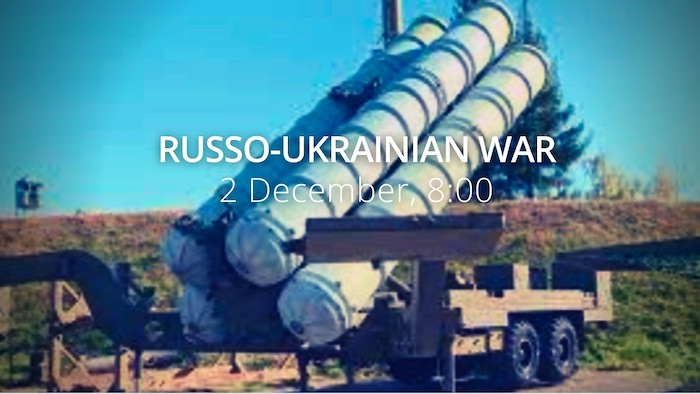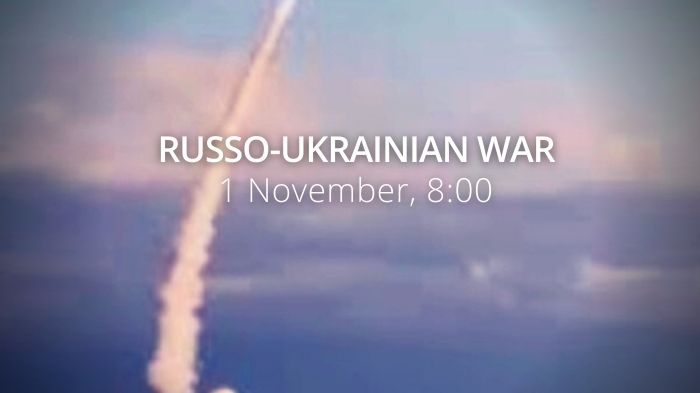Daily overview — Summary report, December 6
A map of the approximate situation on the ground in Ukraine as of 00:00 UTC 06/12/22.
There have been no notable changes to control since the last update. pic.twitter.com/FwdmJcHdQ0
— War Mapper (@War_Mapper) December 6, 2022
The General Staff’s operational update regarding the Russian invasion as of 06.00 am, December 6, 2022 is in the dropdown menu below:
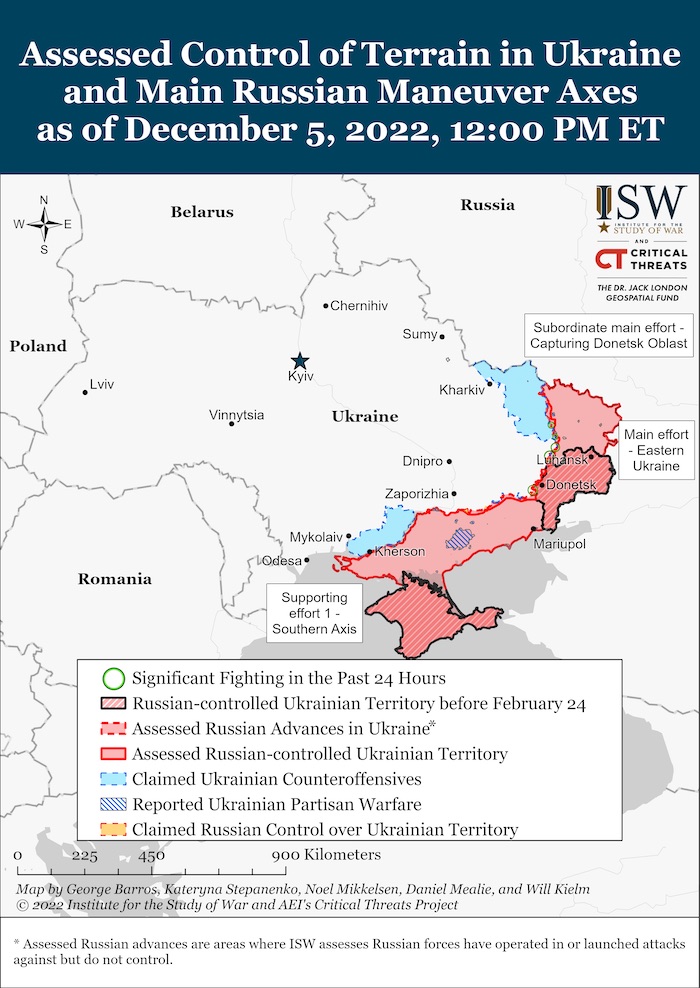
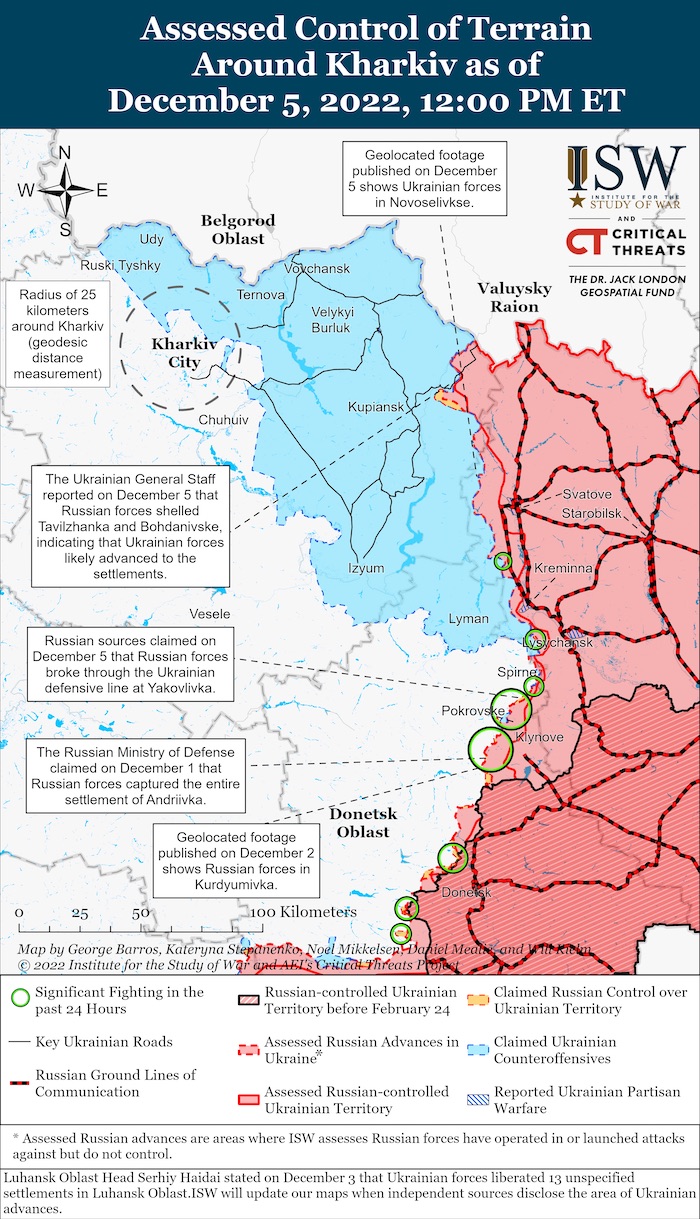
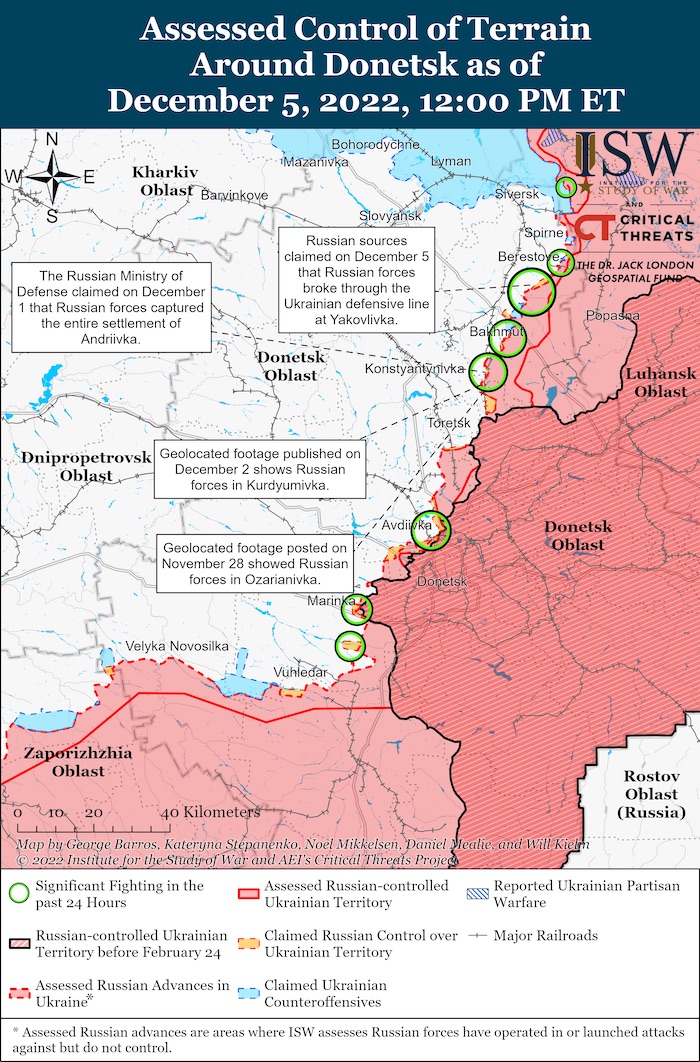
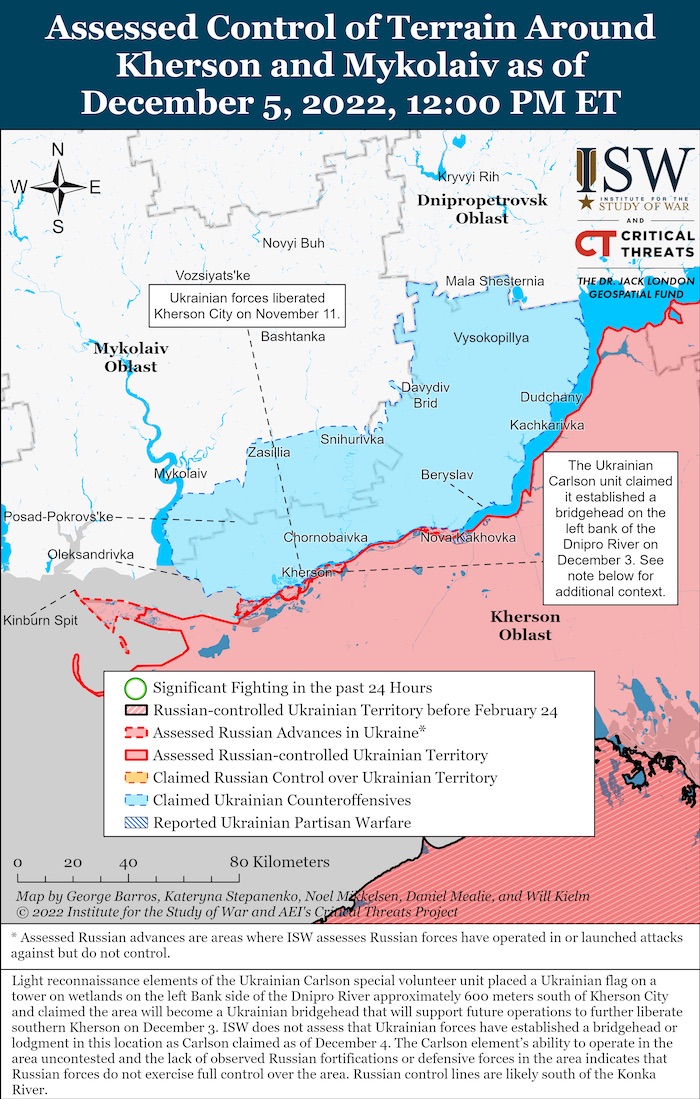
Military Updates
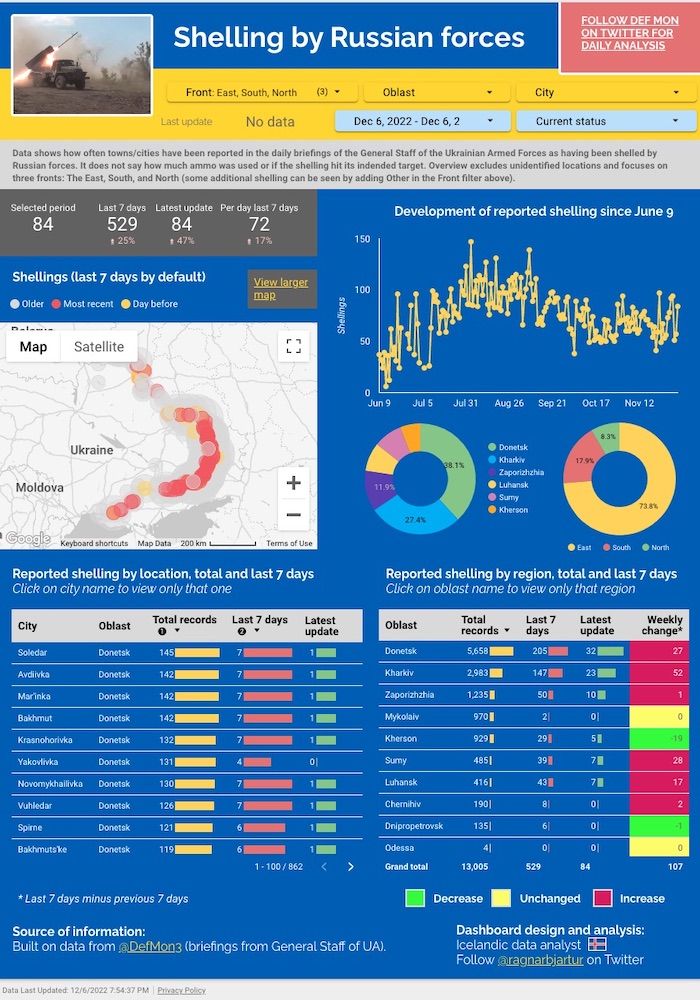
In addition to that, long-range Tu-22M3 bombers attacked Ukraine from the Black Sea with three Kh-22 cruise missiles, and Su-35 fighters fired six Kh-59 guided aircraft missiles and one Kh-31P.
The Air Force reported that in total more than 60 missiles of the invaders were shot down, and units of anti-aircraft missile units, aircraft, mobile fire groups of the Air Force of the Armed Forces of Ukraine and other parts of the Defence Forces of Ukraine were involved in repelling the attack.
On the afternoon of 5 December, explosions rocked Odesa, Vinnytsia, Zaporizhzhia, as well as Cherkasy and Kyiv oblasts. There are problems with electricity and water supply in some oblasts.”
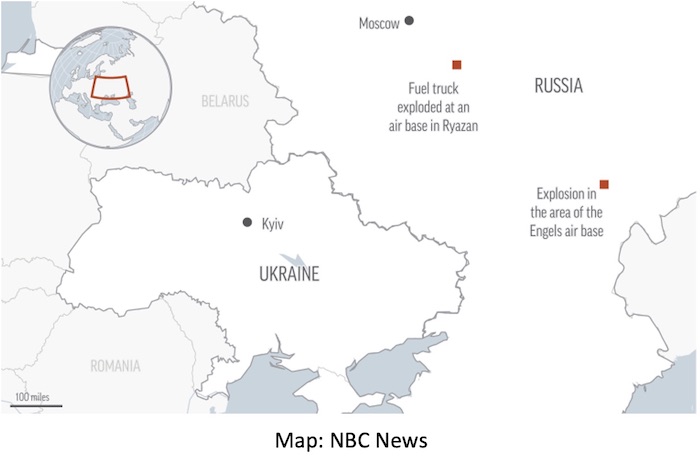
Russian media report an explosion at one Russian airfield and a drone crash at another, Ukrainska Pravda reports, citing RIA Novosti, Meduza, Latvia-based Russian media outlet, citing Astra and Baza. “Russian media report that a fuel tanker ignited and subsequently exploded at an airfield in Ryazan. Three people were killed, and six more were injured. The news outlets also reported that a drone fell on a runway in Saratov Oblast. Two Tupolev Tu-95 bomber jets were damaged. Injured servicemen were hospitalised. […]
Long-range Russian aviation is stationed at both airfields. The Dyagilyaevo airfield is located near Ryazan, and the Engels airfield is in Saratov Oblast. In particular, there are Tupolev Tu-95MS, Tu-160, and Tu-22M3 missile-carrying bombers based there. The main characteristic of these planes is their ability to launch deadly cruise missiles from a distance of more than 1000 kilometres.”
For the first time since 1991, Ukraine launched massive production of 152mm ammunition for Soviet artillery
The production is split between many cities to avoid vulnerability to missiles. Ukrainian celebrities wrote hello to occupiers on the first rounds. https://t.co/JjQei5AEwk pic.twitter.com/hAovtyBFcB
— Euromaidan Press (@EuromaidanPress) December 6, 2022
The Russian Ministry of Defense claimed that the Armed Forces of Ukraine launched an attack on military airfields in the Saratov and Ryazan regions, RIA Novosti reported citing the press service of the Ministry of Defense. According to the ministry, three military technical personnel were killed in the attack and four more were injured. Russian Air Defence allegedly intercepted Ukrainian UAVs flying at low altitudes.
"As a result of the fall and explosion of fragments of jet drones at Russian airfields, the hull of two aircraft was slightly damaged, the ministry said.”
https://twitter.com/EuromaidanPress/status/1599831972020297728
Belarus prolongs terms of army’s combat readiness check, Ukrainska Pravda reports, citing the Ukrainian General Staff. “Belarus has prolonged the term of combat readiness of the Armed Forces of the Republic of Belarus check till 12 December.”
- On 05 December 2022, multiple open sources reported explosions at Engels Airbase, in Russia’s Saratov Oblast, and at Dyagilyaevo airfield near Ryazan, south-east of Moscow. Two Tu-95 BEAR heavy bombers were reportedly damaged at Engels and three people were killed when a fuel tank exploded at Dyagilyaevo.
- The causes of the explosions have not been confirmed. However, if Russia assesses the incidents were deliberate attacks, it will probably consider them as some of the most strategically significant failures of force protection since its invasion of Ukraine. The sites are much deeper inside Russia than previous similar explosions: Engels is over 600km from Ukrainian-controlled territory.
- Engels is the main operating base of Russia’s Long Range Aviation (LRA) within western Russia and is home to more than 30 heavy bombers. These aircraft contribute to Russia’s nuclear deterrent and have also frequently been used to launch conventional cruise missiles at Ukraine. The LRA is likely to respond by temporarily moving bombers to dispersal airfields. The Russian chain of command will probably seek to identify and impose severe sanctions on Russian officers deemed responsible for allowing the incident.
- In recent months, the number of sorties conducted by Russian tactical combat aircraft over Ukraine has reduced significantly. Russian aircraft now probably conducts tens of missions per day, compared to a high of up to 300 per day in March 2022.
- Russia has now lost over 60 fixed-wing aircraft in the conflict, likely including an additional Su-24M FENCER fighter-bomber and a Su-25 FROGFOOT ground attack aircraft last week.
- The decrease in sorties is likely a result of continued high threat from Ukrainian air defences, limitations on the flying hours available to Russian aircraft, and worsening weather. With Russia’s ground attack tactics largely reliant on visual identification and unguided munitions, the Russian air force will likely continue a low rate of ground attack operations through the poor winter weather.
The illegal and unprovoked invasion of Ukraine is continuing.
The map below is the latest Defence Intelligence update on the situation in Ukraine – 06 December 2022
Find out more about the UK government's response: https://t.co/r0DIE7FEvx
🇺🇦 #StandWithUkraine 🇺🇦 pic.twitter.com/b7WmG8X6Ww
— Ministry of Defence 🇬🇧 (@DefenceHQ) December 6, 2022
According to British Defence Intelligence, (last 48 hours):
- On 05 December 2022, multiple open sources reported explosions at Engels Airbase, in Russia’s Saratov Oblast, and at Dyagilyaevo airfield near Ryazan, south-east of Moscow. Two Tu-95 BEAR heavy bombers were reportedly damaged at Engels and three people were killed when a fuel tank exploded at Dyagilyaevo.
- The causes of the explosions have not been confirmed. However, if Russia assesses the incidents were deliberate attacks, it will probably consider them as some of the most strategically significant failures of force protection since its invasion of Ukraine. The sites are much deeper inside Russia than previous similar explosions: Engels is over 600km from Ukrainian-controlled territory.
- Engels is the main operating base of Russia’s Long Range Aviation (LRA) within western Russia and is home to more than 30 heavy bombers. These aircraft contribute to Russia’s nuclear deterrent and have also frequently been used to launch conventional cruise missiles at Ukraine. The LRA is likely to respond by temporarily moving bombers to dispersal airfields. The Russian chain of command will probably seek to identify and impose severe sanctions on Russian officers deemed responsible for allowing the incident.
- In recent months, the number of sorties conducted by Russian tactical combat aircraft over Ukraine has reduced significantly. Russian aircraft now probably conducts tens of missions per day, compared to a high of up to 300 per day in March 2022.
- Russia has now lost over 60 fixed-wing aircraft in the conflict, likely including an additional Su-24M FENCER fighter-bomber and a Su-25 FROGFOOT ground attack aircraft last week.
- The decrease in sorties is likely a result of continued high threat from Ukrainian air defences, limitations on the flying hours available to Russian aircraft, and worsening weather. With Russia’s ground attack tactics largely reliant on visual identification and unguided munitions, the Russian air force will likely continue a low rate of ground attack operations through the poor winter weather.
Losses of the Russian army
As of Tuesday 6 December, the approximate losses of weapons and military equipment of the Russian Armed Forces from the beginning of the invasion to the present day:
- Personnel – about 92200 (+510),
- Tanks – 2929 (+5),
- Armoured combat vehicles – 5905 (+5),
- Artillery systems – 1915 (+1),
- Multiple rocket launchers –MLRS - 395 (+0),
- Air defence means – 211 (+0),
- Aircraft - 281 (+0),
- Helicopters - 264 (+0),
- Automotive technology and fuel tanks – 4505 (+8),
- Vessels/boats - 16 (+0),
- UAV operational and tactical level – 1587 (+5),
- Special equipment – 163 (+0),
- Mobile SRBM system – 4 (+0),
- Cruise missiles – 592 (+61)
Russian cruise missiles were made just months ago despite sanctions, The New York Times reports. “Weapons investigators in Kyiv found that at least one Russian Kh-101 cruise missile used in widespread attacks there on Nov. 23 had been made no earlier than October. Some of the cruise missiles that Russia launched at Ukraine’s civilian infrastructure in late November were manufactured months after the West imposed sanctions intended to deprive Moscow of the components needed to make those munitions, according to a weapons research group.
Experts examined remnants of Kh-101 cruise missiles found in Kyiv, the capital, after an attack on Nov. 23 that knocked out electricity and shut down water systems in large areas of the country. One of the missiles was made this summer, and another was completed after September, markings on the weapons show, according to a report released by the investigators on Monday
.
That Russia has continued to make advanced guided missiles like the Kh-101 suggests that it has found ways to acquire semiconductors and other matériel despite the sanctions or that it had significant stockpiles of the components before the war began, one of the researchers said.
The findings are among the most recent by Conflict Armament Research, an independent group based in Britain that identifies and tracks weapons and ammunition used in wars. A small team of its researchers arrived in Kyiv just before the attack at the invitation of the Ukrainian security service.
In four previous research trips to Kyiv since the invasion, the investigators found that almost all of the advanced Russian military gear they examined — like encrypted radios and laser range finders — was built with Western semiconductors. […]
Pentagon officials say Russia has fired thousands of long-range weapons like cruise missiles as well as short- and medium-range ballistic missiles at targets in Ukraine since the war began.
Whether Russia has depleted its inventory of older cruise missiles is unclear. But militaries often use older munitions first in combat because they typically make up a majority of a nation’s stockpile.
On Nov. 23, the same day as the cruise missile attack on Kyiv, Lloyd J. Austin III, the secretary of defence, told reporters that Russia’s supply of precision-guided weapons had been significantly reduced” and that it would be more difficult for Russia to rapidly produce them “because of the trade restrictions they have on microchips and other types of things.
But Damien Spleeters, who led Conflict Armament Research’s investigation, said it would be difficult to say that the Russians are running short on weapons. Those claims have been made since April, he said, “so we’re just pointing to the fact that these cruise missiles being made so recently may be a symptom of that, but it’s not a certainty.”
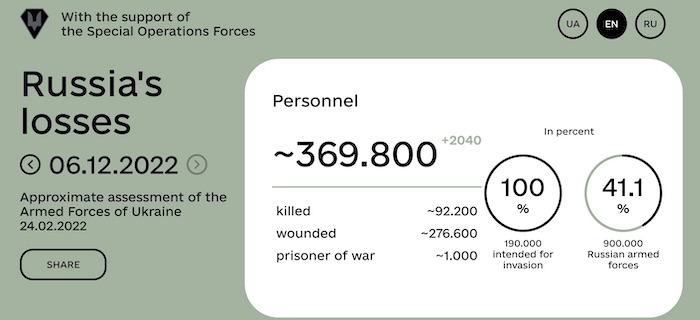
Humanitarian
Russians hit energy facilities in three oblasts of Ukraine, Ukrainska Pravda reports, citing the Ukrainian Prime Minister, Denys Shmyhal. "The terrorist country Russia has once again tried to implement its criminal plan to immerse Ukraine into darkness and cold. Thanks to the heroic Armed Forces of Ukraine and Air Defence units, Russian forces have once again failed to carry out their plan. The energy system of the country is functioning and remains integrated.
There were hits in Kyiv, Vinnytsia and Odesa oblasts. There are emergency power shutdowns implemented in some regions in order to balance the system and avoid accidents. Specialists are already working on removing the consequences of the attack, so that electricity is back in every home."
Shmyhal has pointed out that Russia launched this large missile attack on the anniversary of signing the Budapest Memorandum. They are showing to the world how ‘reliable’ of a security guarantor they are.”
Emergency power shutdowns implemented in Kyiv, Dnipropetrovsk, and Donetsk oblasts, Ukrianska Pravda reports, citing DTEK [the largest private investor in the energy industry in Ukraine]. “Emergency power shutdowns were implemented due to another large attack by the Russian Federation on critical infrastructure facilities in Kyiv, Dnipropetrovsk and Donetsk oblasts.”
Almost half of Kyiv region will have no electricity in coming days - region’s administration, Ukrinform reports, citing Oleksiy Kuleba, head of the Kyiv Regional Military Administration. “Works on eliminating the consequences of Russian missile attacks are underway in the Kyiv region. NEC Ukrenergo power grid operator has introduced additional emergency shutdowns. Therefore, schedules of hourly power outages are currently not in effect in the region.”

OHCHR recorded 688 civilian casualties in Ukraine as of the period from 1 to 30 November. 162 were killed (including 11 children) and 526 injured (including 32 children).
UN: More than 6,700 civilians killed in Ukraine since the Russian invasion started, Ukrinform
reports. “Since the beginning of Russia’s full-scale invasion, the UN Office of the High Commissioner for Human Rights (OHCHR) has recorded 17,181 civilian casualties in Ukraine, including 6,702 killed and 10,479 injured.
This is said in the organization’s latest update on civilian casualties in Ukraine, according to Ukrinform. It is noted that most of the civilian casualties recorded were caused by the use of explosive weapons with wide-area effects, including shelling from heavy artillery, multiple launch rocket systems, missiles and air strikes.
OHCHR stresses that the actual figures are considerably higher, as the receipt of information from some locations where intense hostilities have been going on has been delayed.”
Hans Petter Midttun: Based on unconfirmed numbers from Mariupol, being only one out of several cities and settlements still under Russian control, the actual numbers of civilian casualties might be 20-30 times higher than what the UN stipulates.
️Environment
Russia refuses to relinquish control over the Zaporizhzhia Nuclear Power Plant for the creation of nuclear safety zone, Ukrainska Pravda reports. “Maria Zakharova, the official representative of the Ministry of Foreign Affairs of Russia, said Russia would not give up control over the Zaporizhzhia Nuclear Power Plant (ZNPP) within the framework of an agreement to create a nuclear safety and security zone around it.
There can be no question of removing the ZNPP from Russian control or handing control over to some ‘third party’. The power plant is located in Russian territory and is fully managed by Russia, she claimed. According to Zakharova, Moscow is proceeding from the fact that "we are the only ones who can ensure the physical and nuclear security of the ZNPP".
She also refuted a statement by Rafael Grossi, Director General of the International Atomic Energy Agency (IAEA), who said that Ukraine and Russia were close to reaching an agreement on the ZNPP. The fundamental issue is whether Kyiv is prepared to undertake to stop the attacks and give up its attempts to take over the ZNPP, and also whether the IAEA will be able to get the Ukrainians to comply with such hypothetical agreements, Zakharova said.
The situation at the ZNPP has been at the centre of attention since the beginning of August, when Russian forces started to launch attacks on it. Russia has rejected calls for the power plant to be demilitarised, claiming that it has to "protect it" from provocations and blaming Ukraine for the attacks.”
Legal
Over 2,000 Ukrainian schools and kindergartens are under occupation, Ukrainska Pravda reports. “More than 2,000 schools and kindergartens are currently under temporary Russian occupation. This is the data as of 24 November, as stated in a report from the Ministry of Education and Science of Ukraine.”
443 children were killed, 852 children injured - the Office of the Prosecutor General of Ukraine reports as of December 5. 51,250 crimes of aggression and war crimes and 18,571 crimes against national security were registered.
Support
The More War Crimes Russia Commits, the More Weapons Should Be Provided to Ukraine - Ukraine's MFA, European Pravda reports. “Minister of Foreign Affairs, Dmytro Kuleba, following Russian missile strikes on Ukraine, has called on partners to increase the supply of weapons to Ukraine to stop Russian terror.
Russia has fired another barrage of missiles at our critical civilian infrastructure trying to deprive people of power, water, and heating amid freezing temperatures. The more war crimes Russia commits, the more weapons should be provided to Ukraine to end Russian terror sooner, Kuleba wrote on Twitter.
The Ministry of Foreign Affairs of Ukraine stated that following the missile crash on the territory of Moldova after the Russian attack on Ukraine once again proves that Russian missile terror poses a huge threat not only to the security of Ukraine but also to the security of neighbouring countries.
Nordic nations may pool their growing military support to Ukraine, Defense News reports. “Nordic governments are exploring a number of joint initiatives to support Ukraine’s defense against Russia, including proposals for shared weapons buys, coordinating arms donations and expanding logistics cooperation to safely transport military equipment to the war-torn country. […] The monetary value of support by Sweden, Norway, Finland and Denmark to Ukraine is set to exceed $2 billion by year’s end. […]
Finland is moving ahead with its 10th military aid package (MAP) to Ukraine since Russia invaded that country in February 2022. The latest shipment of weapons, which is valued at $58.5 million, includes specialist sniper rifles, mortars, munitions, in addition to extreme climate combat equipment and clothing. The latest batch of aid increases Finland’s total spending on defense equipment to Ukraine to around $200 million.
Among the Nordic states, Sweden is set to become the largest provider of direct military aid to Ukraine in 2022. Sweden has ratified a new MAP for Ukraine, worth $290 million, that will include an air defense system and munitions from the Swedish Armed Force’s (SAF) stockpile. The delivery will be Sweden’s biggest aid package since the outbreak of war. […] Sweden’s $290 million package may include the military’s RBS 70 (Robotsystem 70) man-portable air-defense system which is designed for anti-aircraft warfare in all climate zones. RB 70 missiles can also be deployed in some of the armed forces’ other missile systems. […]
Danish-delivered military support deliveries for Ukraine have included shoulder-launched anti-tank weapons and Harpoon long-range anti-ship missiles sourced from the Danish Defense Forces’ (DDF) stocks. In August, the Danish government approved a new MAP valued at $141.2 million to finance weapons procurement and training.
For its part, Norway has allocated $443 million to a financially reinforced military support program for 2022-2023. In addition, the country plans to contribute $1 billion in civilian and humanitarian aid to Ukraine over the same period. Norway’s $443 million MAP will cover the procurement of artillery, Arctic weather combat equipment and other defensive weapons systems, in addition to training programs for Ukrainian soldiers. Norway is also providing funds to weapons acquisition programs led by NATO, the European Union and Britain.
In MAPs completed since March 2022, Norway has donated over 4,000 M72 anti-tank weapons and an air-defense-system weapons from the Norwegian Armed Forces’ (NAF) stockpiles to Ukraine. MAP shipments to Ukraine have included 14 Iveco LAV III Armored Vehicles and 23 self-propelled artillery vehicles (M109 howitzers), including associated gear, spare parts and ammunition. In addition, Norway entered agreements to purchase M72 anti-tank weapons and M141 rocket launchers, in deals totaling $30 million, for direct onward supply to Ukraine”
Support slipping for indefinite US aid to Ukraine, poll finds, The Washington Post reports. “A strong majority of Americans continue to support sending arms and economic aid to Ukraine, according to a poll released Monday. But as the conflict drags into winter, Americans are divided over whether Washington should push Ukraine to reach a negotiated peace as soon as possible.
More than two-thirds of respondents back supplying Ukraine with weapons and economic assistance, and about three-quarters support accepting Ukrainian refugees and sanctioning Russia, according to the survey conducted by the Chicago Council on Global Affairs last month.
While support among the American public for assistance to Ukraine remains robust, Republican backing for aid to Ukraine has slipped since the spring, with 55 percent of Republicans saying they support sending military aid, compared with 68 percent in July and 80 percent in March. Half of Republicans favored providing economic assistance to Ukraine last month, compared with roughly three-quarters in March, according to the Chicago Council’s findings. […]
With Russia’s war in Ukraine in its 10th month, and no end in sight, Americans are split over whether Washington should urge Ukraine to reach a peace settlement with Russia imminently, the survey found. A plurality — 40 percent — said the United States should continue its current levels of support to Ukraine indefinitely. Fifty-three percent of Democrats favor this approach. In July, however, 58 percent of American respondents said the United States should help Ukraine for as long as it takes, even if that meant higher gas and food prices for American consumers. Now, 47 percent say Washington should push Kyiv to reach a peace settlement soon.
A plurality of Republicans, however, would opt to gradually withdraw US support from Ukraine. Overall, 29 percent of respondents hold this view, while about a quarter said the United States and its allies should intervene militarily to help Ukraine win the war quickly. […]
With Republicans soon to take control of the House of Representatives, ushering in an era of divided government, proposals for additional aid to Ukraine could face more resistance. Ahead of the midterm elections last month, some Republican candidates campaigned on ending financial support for Ukraine. Rep. Kevin McCarthy (R-Calif.), the Republican nominee to be the next House Speaker, has said Republicans will not write a “blank check” for Ukraine.
New Developments
Zelenskyy becomes FT's person of the year 2022
"44 yo earnt place in history for his extraordinary leadership & fortitude"
"I am more responsible than brave," Zelenskyy told FT that compares Zelenskyy w/ Churchill who"went on radio to rally during Blitz" https://t.co/m9QV1SEU8m pic.twitter.com/uez6BmONCz
— Euromaidan Press (@EuromaidanPress) December 5, 2022
- Zelenskyy on Russia: signing something with these terrorists will not bring peace, Ukrainska Pravda reports, citing President Zelenskyy. “Russia’s latest massive missile attack on Ukraine on the anniversary of the signing of the Budapest Memorandum proves that no agreements with the terrorist state are possible.”
- Kuleba urges the world to prepare for Russia's defeat, Ukrainska Pravda reports, citing Dmytro Kuleba, the Minister of Foreign Affairs of Ukraine. "Dear politicians, experts, representatives of the media and academia abroad. I know that it is difficult for some of you to imagine a Ukrainian victory, but we are on our way to it. It is better to prepare for Russia's defeat right now rather than try to explain why Ukraine cannot or should not win."
- Kremlin sees no shifts in EU policy toward diplomatic settlement in Ukraine — Spokesman, TASS “Earlier, it was reported that the French leader Emmanuel Macron emphasized that he did not see any military resolution to the Ukrainian conflict and asserted that the only way to resolve the situation is through negotiations. Kremlin Spokesman Dmitry Peskov told journalists on Monday that the Kremlin does not see any shifts in European policy directed at a diplomatic settlement in Ukraine.”
- Ukraine, Baltics rebuke Macron for suggesting 'security guarantees' for Russia, Reuters “French President Emmanuel Macron's suggestion the West should consider Russia's need for security guarantees if Moscow agrees to talks to end the war in Ukraine unleashed a storm of criticism in Kyiv and its Baltic allies over the weekend. […] Ukrainian President Volodymyr Zelenskyy's top aide, Mykhailo Podoliak, said that it is the world that needs security guarantees from Russia, not the other way around. […]
One of the missiles fell on the territory of Moldova near Briceni town.https://t.co/Fzo2IDVNn2 pic.twitter.com/RJxciYWBfx
— Euromaidan Press (@EuromaidanPress) December 5, 2022
Macron's suggestion of security guarantees for Moscow has also spurred criticism in some Baltic countries that border Russia and see it as a growing threat. Former Finnish prime minister Alexander Stubb said he fundamentally disagreed with Macron. The only security guarantees we should focus on are essentially non-Russian," he said on his Twitter account. Russia needs first to guarantee that it does not attack others.
Lithuania's former foreign minister, Linas Linkevicus, said that Russia has security guarantees as long as it does not attack, annex or occupy its neighbours. If anyone wants to create a new security architecture that allows a terrorist state to continue its methods of intimidation, they should think again, it will (n)ot fly," Linkevicus said on Twitter.”
- Missile crashes in Moldova after Russian attack on Ukraine, Ukrainska Pravda reports, citing Newsmaker. “A missile has been discovered in Moldova near the Ukrainian border after the recent Russian missile attack on Ukraine.”
- Putin bans protests outside universities, railway stations, churches and other places, Ukrainska Pravda reports, citing RIA Novosti. “Russian President Vladimir Putin has greatly expanded the list of places where protests may not be held, including […] in the vicinity of public authority buildings and their adjacent territories, airports, railway and bus stations, ports, in the buildings and on the grounds of universities, schools and hospitals, and in areas where churches and other premises are located. The ban also applies to territory adjacent to vital infrastructure facilities, in particular those that ensure the functioning of electricity, heating, water and gas networks.”
- Three more suspicious envelopes were addressed to Ukrainian diplomats in Spain, Ukrinform "The Spanish police seized at the post office three envelopes with what are believed to be animal eyes, which were addressed to the Embassy of Ukraine in Madrid, the Consulate General in Barcelona and the Consulate in Malaga. The investigation has been launched. In total, we already have 21 cases of threats to Ukrainian embassies and consulates in 12 countries, Spokesperson for the Ministry of Foreign Affairs of Ukraine Oleg Nikolenko posted on Facebook.”
- Putin drives across the Crimea bridge in a Mercedes, Reuters “President Vladimir Putin on Monday drove a Mercedes across the Crimean Bridge linking southern Russia to the annexed Crimean peninsula, less than two months since an explosion tore through one of the Kremlin chief's showcase infrastructure projects. The 12-mile (19 km) road and rail bridge, which was personally opened by Putin in 2018, was bombed on Oct. 8 in an attack Russia said was carried out by Ukraine.”
- Finnish parliament to hold NATO vote while awaiting Hungary, Türkiye decisions, Reuters “Finland's government said on Monday it had asked parliament to formally adopt NATO's founding treaty, thus preparing the country for membership of the military alliance once hold-outs Hungary and Türkiye approve the application. […] In May, Finland and neighbouring Sweden applied for membershipin response to Russia's invasion of Ukraine but their applications are conditional on the approval of all 30 members, of which 28 have so far said yes.”
- Foreign ministers of Visegrad Group countries to discuss Russian aggression against Ukraine at an informal meeting, Ukrinform reports, citing Radio Prague International. “The foreign ministers of the Czech Republic, Slovakia, Poland and Hungary will discuss Russian aggression against Ukraine at an informal meeting of the Visegrad Group in Bratislava on December 6. The Visegrad Group is composed of Czechia, Hungary, Poland and Slovakia, with Slovakia currently holding the year-long presidency.”
Assessment
- On the war.
The Institute for the Study of War has made the following assessment as of December 5, 2022:
“Russian forces conducted another wave of missile strikes targeting Ukraine’s energy infrastructure on December 5. Russian and Ukrainian sources reported on December 5 that Russian forces conducted missile strikes targeting Ukrainian civilian and energy infrastructure in Kyiv, Odesa, Vinnetysia, and Zaporizhzhia Oblasts. The Ukrainian General Staff reported that Ukrainian air defenses shot down 60 of over 70 missiles launched. Deputy Head of Ukraine's Presidential Office Kyrylo Tymoshenko Kyrylo Tymoshenko stated that the Russian strikes damaged a power supply line in Sumy Oblast. ISW previously assessed on December 2 that while Ukrainian and Western-provided air defenses are further reducing Russia’s dwindling supply of precision munitions, the small percentage of Russian strikes getting through Ukraine’s air defenses are nevertheless having significant effects on Ukrainian critical infrastructure.
Ukrainian forces likely conducted strikes on two Russian strategic airbases on December 5, inflicting light damage while demonstrating Ukraine’s ability to strike Russian rear areas and possibly disrupt Russia’s campaign of strikes against Ukrainian infrastructure. The Russian Ministry of Defense and several milbloggers reported that Ukrainian forces used UAVs to strike the Engels-2 airbase in Saratov Oblast (approximately 315 miles from Ukrainian territory) and the Dyagilevo Air Base in Ryazan Oblast (approximately 285 miles from Ukrainian territory). Both airbases house elements of Russia’s strategic bomber fleet, which Russia has employed to strike Ukraine throughout the war. Ukrainian Presidential Advisor Mikhail Podoliak tweeted that the Kremlin should have known that “if something is launched into other countries’ airspace, sooner or later unknown flying objects will return to departure point.” Still, Ukrainian authorities have not formally claimed responsibility for the strikes as of publication.[6] Russian sources claimed that a Ukrainian drone struck aircraft at the Engels-2 Airbase in Saratov Oblast, Russia, damaging strategic bombers and missile carriers. Russian sources also claimed that a Ukrainian drone destroyed a Russian fuel truck at the Dyagilevo Air Base in Ryazan Oblast, Russia. The Russian Ministry of Defense claimed that the strike intentionally targeted Russian long-range aircraft. Ukrainian forces likely sought to disrupt Russian strikes against Ukrainian critical infrastructure and demonstrate Ukraine’s ability to target Russian strategic assets.
Anger over the Russian military’s inability to prevent the Ukrainian strikes on Russian strategic airbases over 280 miles from Ukrainian positions outweighed praise for the latest round of strikes against Ukraine within the Russian milblogger community. Russian milbloggers criticized Russian officials for failing to anticipate and prevent the drone strikes at the Engels-2 and Dyagilevo Air Bases on December 5. Select milbloggers noted that Russian military officials have not adequately protected the airbases, with some suggesting that Russian officials did not adequately defend the bases despite knowing that they were clear targets for Ukrainian strikes. Several prominent Russian milbloggers claimed that Ukrainian sabotage and reconnaissance groups must have launched the strike against the Engels-2 air base from inside Russian territory, asserting either that Ukrainian sabotage and reconnaissance groups are active inside Russia or – if the UAVs were launched from Ukrainian territory – that Moscow is under threat from Ukrainian territory.
Russian milbloggers also called on Russian military officials to authorize significant retaliation strikes against Ukraine and intensify counter-terrorism measures within Russian territory. The milblogger community complained that Russian military officials do not consider their suggestions and ignore open-source intelligence (OSINT) and that, had Russian officials taken milbloggers’ warnings into account, the two strikes on Russian military bases would have likely been prevented. Select milbloggers suggested that the strikes on Engels-2 and Dyagilevo Air Bases threaten Russia’s legitimacy as a nuclear power as the strikes damaged aircraft capable of carrying multiple nuclear weapons.
Key inflections in ongoing military operations on December 5:
- Russian forces continued to defend their positions along the Svatove-Kreminna line against Ukrainian attacks.
- Russian forces continued to make incremental gains around Bakhmut but have not yet surrounded the city, and conducted offensive operations in the Avdiivka-Donetsk City area. Ukrainian sources claimed that small Russian assault groups of 15-20 personnel are attempting to penetrate Ukrainian lines.
- Russian occupation officials continued the forceful transfer of Ukrainian children from occupied territories in Donetsk and Luhansk Oblasts to Russia under the guise that the children require special medical care.
- Russian forces shelled more than 20 settlements on the right (west) bank of the Dnipro River and continued to strike Kherson City.
- Russian senator Andrey Klishas of the ruling United Russia party proposed the Kremlin restrict the ability of Russians who fled the country to avoid mobilization to secure work upon returning to Russia.
Ukraine’s Main Intelligence Directorate (GUR) reported that the Russian military, in concert with the Russian Internal Ministry, is taking steps to launch an electronic database by February 2023 to document the personal details of all servicemen and restrict their movement even when out of uniform.“
We can win a battle of production lines with Russia. But there’s a better way, Max Boot argues in The Washington Post. “The conflict in Ukraine has already lasted nearly 10 months, and it has turned into something the United States has not seen since World War II: a battle of production lines. Both Russia and Ukraine have been expending munitions at a furious rate. “At the height of the fighting in Donbas, Russia was using more ammunition in two days than the entire British military has in stock,” notes the Royal United Services Institute, a British think tank.
Not surprisingly, both sides are now running low. Ukrainian intelligence estimates, for example, that the Russians have already expended 80 percent of their Iskander short-range ballistic missiles, which have been used to target Ukrainian cities and energy infrastructure.
With its economy hobbled by Western sanctions — and in particular by restrictions of microchip exports — Russia has turned to North Korea for artillery shells and rockets and to Iran for drones and missiles. British intelligence reports that Russia “has likely very nearly exhausted its current stock” of Iranian self-destructing drones and is waiting for more deliveries. (That China isn’t arming Russia is a huge, hidden win.)
Ukraine, for its part, is struggling to maintain the flow of artillery shells, Stinger antiaircraft missiles, Javelin antitank missiles, HIMARS rockets and other vital weapons systems from the West. NATO members have already provided Ukraine $40 billion in military aid — roughly equal to France’s annual defense budget — and they are finding themselves running low on weapons inventories. “There’s no question that it’s put pressure on our own stockpiles, it’s put pressure on our defense industrial base,” said Undersecretary of Defense Colin Kahl.
It’s vital, but insufficient, for Congress to pass the Biden administration’s new aid request of $37.7 billion for Ukraine. Unfortunately, more funding alone won’t immediately bust through bottlenecks in defense production, raising the need to provide Ukraine with more potent weapons systems to maintain its battlefield progress.
The US Army just awarded Raytheon a $1.2 billion contract to deliver six National Advanced Surface-to-Air Missile (NASAMS) batteries to Ukraine, in addition to the two that are already shooting down Russian missiles. But it will take 24 months to build the additional batteries. Ukraine needs to protect its cities now — not in two years.
While a workaround for the NASAMS might be possible (persuading other US allies to donate their systems in return for the promise of replacements), there is no long-term substitute for ramping up defense production lines in the West to deal with contingencies far beyond Ukraine. All NATO countries scaled back their defense industrial capacity after the end of the Cold War. In the United States, the number of major defense contractors fell from 51 to five, and many production lines were shuttered. In recent years, defense contractors have focused on producing a small number of high-tech weapons systems that were ideal for fighting the global war on terrorism but are insufficient for waging a protracted conflict against a conventional military power such as China or Russia.
“A major industrial expansion programme will be required if the nations of the West are to rebuild the capacity to design, produce and stockpile the large quantities of munitions (and platforms) that will be required for both deterrence and response missions in the twenty-first century,” retired Australian Maj. Gen. Mick Ryan wrote.
But expanding defense production will take considerable time. Mark F. Cancian, an expert on defense industry at the Center for Strategic and International Studies, reminds me “that US mobilization in World War II took about six years,” from 1938 to 1944 — and we are not, of course, going to mount such an all-out mobilization today unless we find ourselves in World War III.
Moreover, building weapons systems today costs a lot more, and takes a lot longer, than during World War II — partly because systems are more sophisticated and partly because bureaucracy is more extensive. Boeing began designing the B-29 long-range bomber in 1938, and by 1946 had produced 2,766 B-29s. By comparison, Lockheed Martin began developing the F-35 fighter in 1995, and the United States currently has only 450 F-35s.
The systems destined for Ukraine aren’t as sophisticated as the F-35, but weapons such as the Javelin, Stinger, HIMARs and even 155mm artillery shells also require specialized production capacity that doesn’t exist in the civilian sector. Cancian tells me that industry is willing to ramp up production, but “they want assurances of long-term commitments” so that they don’t make a major investment in producing weapons that no one wants after the current war ends.
That is a commitment Congress and the Defense Department should make, because we have to be prepared to fight not only Russia but also China. (Efforts to arm Ukraine are delaying efforts to arm Taiwan.) With congressional negotiators agreeing on a defense budget for fiscal 2023 of a whopping $847 billion, the Pentagon should have the resources to pay for expanded weapons production. But rebuilding long-term industrial capacity will not address Ukraine’s immediate needs.
The best solution would be to help Ukraine win the war faster by providing it with higher-end weapons systems such as F-16 fighters, long-range Army Tactical Missile Systems (ATACMS), Abrams tanks and Gray Eagle drones that the Biden administration has so far refused to supply. The Wall Street Journal just reported that the Pentagon even altered HIMARS supplied to Ukraine to prevent it from firing longer-range rockets capable of hitting Russia — even as Russian bases continue to be used for despicable and illegal attacks on Ukrainian civilians. That’s counterproductive self-restraint.
We can win a battle of production lines with Russia (the US economy is 14 times larger), but we should be doing everything possible to minimize the cost and length of the conflict so that we don’t have to. If you think the supply strains are bad today, imagine what they will look like if the war is still raging at its current tempo a year from now. That’s a scenario we need to avoid if we can.»
War and sanctions threaten to thrust Russia's economy back in time, The New York Times reports. “While Russia’s economy has not collapsed, an exodus of Western companies is eroding hard-won progress, and experts say the worst may be yet to come. More than nine months after the invasion, neither the war effort nor the economy has collapsed, and the economic pain is still limited for many Russians. Mr. Putin has avoided any substantive domestic pressure that would threaten his leadership. But the impact of what some have described as the most coordinated and deepest economic sanctions in modern history is evident in communities across Russia — and the worst may be yet to come.
The sanctions have stymied Russia’s faltering attempts to modernize its economy along Western lines and to catch up to European living standards after the fall of the Soviet Union, said Vladislav Inozemtsev, the Washington-based director of the Center for Post-Industrial Studies, a Russian research group. That has dimmed the hope that the country could become a modern, prosperous nation in the near term. […] Beneath the veneer of normalcy, he said, key drivers of growth, like technology transfer and investment, are eroding. [...]
The most visible and dramatic impact has been on manufacturing, a sector that employs 10 million Russians and that has been the centerpiece of Mr. Putin’s ambitious program to diversify the economy away from reliance on oil and gas exports. The auto industry accounts for a large percentage of those workers: Carmakers employ 300,000 Russians, according to the country’s statistics agency, and the association representing their interests say that up to 3.5 million more work in related industries.
By September, output in the auto industry was down 77 percent year over year, while car sales have plummeted 60 percent compared with the same period in 2021. A primary reason is that Russian industries are highly dependent on Western components. Even Mr. Putin has acknowledged the problem, admitting last week that, in some sectors, dependence on imported parts is as high as 90 percent.
To adapt, Russia is turning inward, cutting ties with the rest of the world and moving toward an economic model similar to one adopted by Iran, where political legitimacy rests on providing citizens with the essentials rather than spurring transformative growth, Mr. Inozemtsev said.
Russia’s government was better prepared to withstand the sanctions than many in the West expected. Since the start of the war, the International Monetary Fund has revised its economic outlook for Russia upward twice and is forecasting a 3.5 percent decline in gross domestic product this year, similar to the government’s projections. This decline, while a major reversal from prewar growth expectations, stands in sharp contrast to the double digits collapse of Venezuela’s economic output after a wave of American sanctions in 2019. […]
A combination of high oil revenues, large currency reserves and an expert team of economic officials has allowed Mr. Putin to soften the blow — much to the frustration of some Western leaders who had hoped the sanctions would have more bite by now.
But the loss of investment, technology and skills caused by the sanctions is likely to echo across generations, depriving many Russians of a chance at a better economic future, experts said. […]
Natalia Zubarevich, a geography professor who tracks social economic data at Moscow State University, said: “What we’re seeing is falling income, broad depression, less consumption. All this will negatively impact the economy of the country.”
Hans Petter Midttun: “We can win a battle of production lines with Russia […], but we should be doing everything possible to minimize the cost and length of the conflict so that we don’t have to. If you think the supply strains are bad today, imagine what they will look like if the war is still raging at its current tempo a year from now. That’s a scenario we need to avoid if we can,» Max Boot argues.
He highlights the extreme rate of expenditure on ammunition on the battlefields in Ukraine, the West running low on reserves, the lack of capacity in the defence industry to meet the increased demands and the time and long-term commitment needed to be able to ramp up production.
Defence aid urgently needed in Ukraine yesterday is being set in production today for delivery in 2 years. That hardly meets its urgent needs.
He could have also highlighted that several countries are taking strategic risks supporting Ukraine at the cost of their own deterrence. Some have emptied their stocks of MANPADS and Advanced Anti-Tank Weapon Systems in support of Ukraine knowing that they will not be replaced within the next couple of years. The US stockpiles are low on cruise missiles, such as Harpoons and Tomahawks; joint direct attack munitions; and the munitions heavily used by the Ukrainians, such as Javelin anti-tank missiles and High Mobility Artillery Rocket System.
The total annual US production of 155 mm artillery shells only supports two weeks of combat in Ukraine, according to Alex Vershinin, a US procurement expert who says the conflict marks “the return of industrial warfare”. It presently takes 13 to 18 months from the time orders are placed for munitions to be manufactured. The war has exposed years of under-investment across many areas of defence, particularly in war stocks of ammunition. The production time for missiles, tanks and armoured vehicles is longer.
Still, the defence industries are years away from being able to ramp up their production. In the US, the Pentagon works with only 5 defence contractors. In the 1990s the number was 51. Additionally, the industry is facing supply chain problems, labour constraints and inflationary pressures that could hold back efforts to scale up production. Some of the electronic components used in existing weapon systems were last manufactured at scale decades ago and are no longer commercially available.
They also lack the reassurance from governments that investments in increased production capacity – infrastructure, technology, manpower - aren’t a short-term fluke.
The NATO sustainability concerns are increasing.
As the war in Ukraine shows little sign of abating, Kyiv’s Western partners are grappling with how to maintain a supply of arms and ammunition to Ukraine, which has proven decisive on the battlefield, without letting their stockpiles dwindle to the point that it could jeopardize their own readiness levels.
“I think everyone is now sufficiently worried,’” said a NATO official who spoke on condition of anonymity, adding that allies had called on Western defence contractors to ramp up production in the wake of the war. […] NATO is now discussing how to support members if their stockpiles fall below the levels needed to meet their defence obligations under the North Atlantic Treaty, the official said.
As a consequence, the flow of new international support for Ukraine has, therefore, been drying up and more countries are becoming reluctant to supply weapons and ammunition.
I have repeatedly stressed that the West is not providing Ukraine with the tools it needs to defeat and evict the Russian forces, even though Euro-Atlantic security and stability are at stake. NATO has decided to limit its engagement to the political sphere, deciding to provide Ukraine with nonlethal support only. The member states have donated only 1.4-3.6% of their heavy weapons systems.
The need for artillery remains acute. Ukraine has practically run itself out of Soviet-standard artillery. Of the 1,500 Soviet artillery systems that it had at the beginning of the war, more than half were lost by end of September. Partly due to extensive wear and tear of old systems and partly due to battle damages. The transition to NATO artillery began in April already. Ukraine has since received about 400 artillery systems, compensating only 25-30% of their losses.
After having been exposed to up to 300 air sorties a day during the first phase of the invasion, the West only responded to Ukraine’s cry for Air Defence means when Russia started attacking the Ukrainian Energy Sector in October. While the system delivered to a certain degree has helped Ukraine defend its critical infrastructure, the support is still inadequate. Too little, too late. Again.
In August I predicted that “The West is running out of weapons it can supply Ukraine”. Having made a similar assessment of the situation as Max Boot did, I concluded that:
The war will continue to evolve in the time to come unless NATO, the EU and the USA finally decide to join Ukraine in its efforts to defend Euro-Atlantic security.
I have long argued that Western […] intervention in Ukraine is inevitable. Despite the US and NATO's continued declarations that they will not deploy military forces to help defend Ukraine, it is bound to happen.
The West is running out of weapons it can supply Ukraine which it can use with no or limited training. The options left for us are either to see Ukraine fail or to provide it with both the weapons and the personnel needed to operate them efficiently. […]
The reality is that the West is fast reaching a long-predicted milestone. In the same manner, as logistics forced Russia to adjust its initial operational objectives for the invasion, logistics are about to force the Alliance to change its strategy. NATO will need to start acting according to NATO's strategic concept 1999-2022: Stop ongoing conflicts threatening the security of its member states.
It’s time to end the war. It’s high time we provide Ukraine with the tools it needs to defeat Russia. It is not at least, time for us to step in and fight alongside our Ukrainian friends and partners to both defend Ukrainian territorial integrity and sovereignty, as well as protect Euro-Atlantic security and stability.
The war didn’t start on 24 February 2022. It only marked the time we finally started to help Ukraine build deterrence. Eight years too late to stop the Russian invasion. Let us provide the support that is needed before it’s too late. Close the sky. Break the embargo. Evict the Russians. Liberate all of Ukraine. Contain Russia.
I have strenuously argued in favour of giving Ukraine combat aircraft, attack helicopters, modern tanks, more artillery and HIMARS, and not least, long-range fire. Denying Ukraine, the ability to attack legal targets in Russia as the latter is pounding the Ukrainian energy sector, trying to increase what is already the biggest refugee crisis since World War 2, is utterly meaningless. Allowing Russia to target civilian society with impunity is utterly disgraceful.
In the words of Max Boot:
The best solution would be to help Ukraine win the war faster by providing it with higher-end weapons systems such as F-16 fighters, long-range Army Tactical Missile Systems (ATACMS), Abrams tanks and Gray Eagle drones that the Biden administration has so far refused to supply.”
A military intervention – pitting Russia against 31 countries – would fundamentally alter the military balance and help Ukraine win the war even faster. It would stop the “tsunami of ripple effects” from the war. It would provide Russia with an off-ramp without the West compromising on its core values and principles. It would not least, demonstrate the will and ability needed to risk further escalation of the broader confrontation between Russia and the US, NATO and the EU.
Faster rather than later is becoming increasingly important as support for indefinite US aid to Ukraine is slipping, most likely reflecting the mood in Europe as countries are facing increasing costs and political instability as a consequence of the war.



